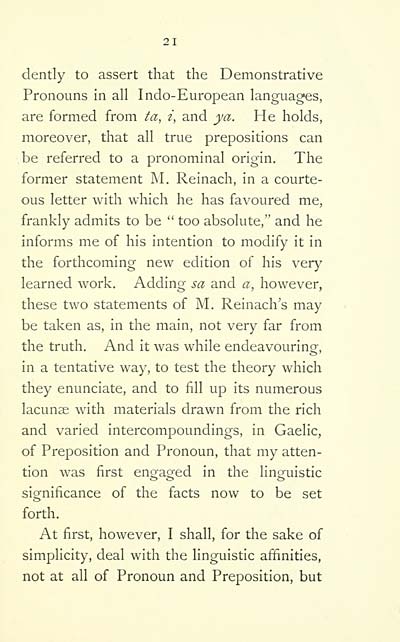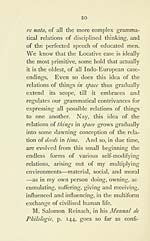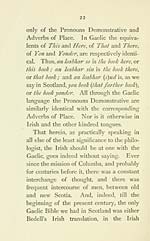Blair Collection > Vestigia celtica
(25)
Download files
Complete book:
Individual page:
Thumbnail gallery: Grid view | List view

21
dently to assert that the Demonstrative
Pronouns in all Indo-European languages,
are formed from ta, i, and ya. He holds,
moreover, that all true prepositions can
be referred to a pronominal origin. The
former statement M. Reinach, in a courte-
ous letter with which he has favoured me,
frankly admits to be " too absolute," and he
informs me of his intention to modify it in
the forthcoming new edition of his very
learned work. Adding sa and a, however,
these two statements of M. Reinach's may
be taken as, in the main, not very far from
the truth. And it was while endeavouring,
in a tentative way, to test the theory which
they enunciate, and to fill up its numerous
lacunae with materials drawn from the rich
and varied intercompoundings, in Gaelic,
of Preposition and Pronoun, that my atten-
tion was first engaged in the linguistic
significance of the facts now to be set
forth.
At first, however, I shall, for the sake of
simplicity, deal with the linguistic affinities,
not at all of Pronoun and Preposition, but
dently to assert that the Demonstrative
Pronouns in all Indo-European languages,
are formed from ta, i, and ya. He holds,
moreover, that all true prepositions can
be referred to a pronominal origin. The
former statement M. Reinach, in a courte-
ous letter with which he has favoured me,
frankly admits to be " too absolute," and he
informs me of his intention to modify it in
the forthcoming new edition of his very
learned work. Adding sa and a, however,
these two statements of M. Reinach's may
be taken as, in the main, not very far from
the truth. And it was while endeavouring,
in a tentative way, to test the theory which
they enunciate, and to fill up its numerous
lacunae with materials drawn from the rich
and varied intercompoundings, in Gaelic,
of Preposition and Pronoun, that my atten-
tion was first engaged in the linguistic
significance of the facts now to be set
forth.
At first, however, I shall, for the sake of
simplicity, deal with the linguistic affinities,
not at all of Pronoun and Preposition, but
Set display mode to: Large image | Transcription
Images and transcriptions on this page, including medium image downloads, may be used under the Creative Commons Attribution 4.0 International Licence unless otherwise stated. ![]()
| Early Gaelic Book Collections > Blair Collection > Vestigia celtica > (25) |
|---|
| Permanent URL | https://digital.nls.uk/75800690 |
|---|
| Description | Celtic footprints in philology ethics and religion. |
|---|---|
| Shelfmark | Blair.1 |
| Additional NLS resources: | |
| Attribution and copyright: |
|
| Description | A selection of books from a collection of more than 500 titles, mostly on religious and literary topics. Also includes some material dealing with other Celtic languages and societies. Collection created towards the end of the 19th century by Lady Evelyn Stewart Murray. |
|---|
| Description | Selected items from five 'Special and Named Printed Collections'. Includes books in Gaelic and other Celtic languages, works about the Gaels, their languages, literature, culture and history. |
|---|

